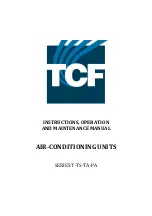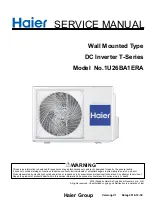
IM 812 / Page 14 of 24
8.
Rotate the fans to be sure they are free of obstruction.
9.
Check all fasteners to make certain they did not loosen
during shipment. Do not loosen the bolts holding down
the compressor.
10. Do not lubricate the motors before start-up. Motors
are factory lubricated. Both motors have permanently lu-
bricated bearings and do not require additional
lubrication.
11. Check all copper tubing and capillaries for proper clear-
ance so they will not hit or rub during operation.
12. When installing the chassis in older McQuay wall sleeves,
bend both 1˝ wide sheet metal tabs, at the rear of the wall
sleeve rails, straight up to allow full insertion of the chassis.
13. Slide the chassis into wall sleeve until firmly seated against
weather seals.
Do not push on the coil surface, control box cover or fan
scroll.
Make sure tubing does not catch when inserting the
chassis.
14. Secure the chassis into the wall sleeve with the four (4)
screws mentioned in step 7.
15. Plug the power cord into the lower RH corner of the chas-
sis and into the power supply receptacle. Excess cord for
208V and 230V units should be coiled neatly and stored
under the control box. Attach the plug/cord cover to front
of subbase on 265V. See Figure 5 page 8. Make sure power
cord is not pinched or kinked.
16. Leave the front panel off until the “Equipment Start-up”
has been completed. (See page 6, and 15-16.)
CAUTION
!
1.
Remove the louver and mounting hardware from the ship-
ping carton and install the mounting studs in the louver.
2.
Remove the temporary cardboard weather panel from wall
sleeve.
3.
Make a temporary handle by looping a piece of flexible
wire or heavy cord through the louver. This enables the
installer to keep a firm grasp on the louver when installing
from inside the room.
The chassis weighs approximately 150 lbs. Use blocking
and lifting devices. Do not raise over any body parts.
1.
Remove the shipping carton and inspect for any shipping
damage. Report any found to the carrier.
2.
Save the shipping carton to cover installed conditioner
until construction is complete.
3.
Remove the two screws attaching the front panel to the
chassis and unlatch the front panel from the chassis by
grasping it at the lower corners and pulling forward. Lift
the front panel off and set aside.
4.
Check the nameplate data on chassis to ensure that the
correct job site distribution has been made with respect
to heating/cooling capacities. Generally, corner rooms
require larger capacities. Also check for the correct volt-
age and max fuse/circuit breaker size.
Improper electrical supply can cause property damage,
severe personal injury or death.
5.
Remove the chassis from carton base by lifting evenly on
the base of unit.
Do not lift by pulling on the tubing. Tubing can crack or
bend, damaging the unit.
6.
Remove the temporary cardboard weather panel from the
wall sleeve and make sure the louver has been installed.
7.
Four (4) tinnerman clips and four (4) screws are included
with the literature packet that ships in each chassis car-
ton. Install the clips on the wall sleeve as shown in Figure
15 and save the screws for step 14.
4.
Angle the louver through the opening at the rear of the
wall sleeve, then pull the louver back to the wall sleeve
flange so that the louver mounting studs pass through
the holes in the outdoor flange.
5.
Secure the louver in place using the nuts and washers
provided.
6.
If the heating/cooling chassis is not to be immediately
installed, replace the cardboard weather panel.
Installation of Louvers
Installation of Chassis
WARNING
!
WARNING
!
Figure 15. Chassis Installation
Tinnerman Clips
Chassis
(with front panel removed)
Ventilation Door Actuator
Wall Sleeve Rails
(See Note 12 Above)
Wall Sleeve
Screws (4)
CAUTION
!










































